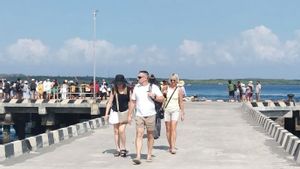JAKARTA - Scientists from the United States Space Agency (NASA) have found evidence that a region of northern Mars called Arabia Terra has experienced thousands of super-eruptions, or the largest known volcanic eruptions, over a period of 500 million years.
The evidence suggests that the eruption was capable of changing the Red Planet's climate for decades afterward. The explosion occurred over 500 million years. The scientists reported these estimates in a paper published in the journal Geophysical Research Letters in July 2021.
"Each of these eruptions will have a significant climatic impact maybe the gases released make the atmosphere thicker or block the Sun and make the atmosphere cooler. Martian climate modelers will have some work to do to try to understand the volcanic impact," said the expert and lead analyst. Arabia Terra, Patrick Whelley as quoted from Slashgear, Thursday, September 16.
To help put it into public perspective, NASA researchers say the amount of gas and lava generated by one of these eruptions would be large enough to fill 400 Olympic-sized swimming pools.
The enormous amount of ash produced would wipe out the Sun over a span of thousands of miles. This eruption left a caldera, which is a large hole where a recently erupted volcano collapses. Similar calderas can be found in various places on Earth.
NASA recorded several of these calderas in the Arabia Terra region of Mars, hinting at ancient eruptions and their profound impact on the Red Planet. Based on previous research, scientists were able to find evidence of ash generated from the eruption.
The thickness of the ash helps pinpoint how many of these ancient explosions may have occurred, numbering in the thousands. The last big bang occurred about 4 billion years ago.
Scientists also used images from Mars' MRO Compact Reconnaissance Imaging Spectrometer to identify minerals on the crater's surface. Looking at the canyon walls and craters from hundreds to thousands of miles from the caldera, where the ash would be carried by the wind, they identified volcanic minerals turned clayey by the water, including montmorillonite, imogolite, and allophane.
Then, using images from the MRO camera, the team created a three-dimensional topographical map of Arabia Terra. By laying out the mineral data on top of the analyzed canyon and crater topographic maps, the researchers were able to see in the mineral-rich deposits that the ash layers were very well preserved.
"That's when I realized this wasn't a coincidence, this was a real signal. We really saw what was predicted and that was the most exciting moment for me," said Jacob Richardson, a geologist at NASA Goddard who worked with Whelley.
So far, NASA has only found evidence of a supervolcanic eruption on Arabia Terra. NASA explains that other types of volcanoes are also located on the Red Planet, including a large shield volcano called Olympus Mons which has 100 times the volume of the newest volcano on Earth. It is currently unclear why so many supervolcanoes are clustered in this particular region of Mars.
The English, Chinese, Japanese, Arabic, and French versions are automatically generated by the AI. So there may still be inaccuracies in translating, please always see Indonesian as our main language. (system supported by DigitalSiber.id)












